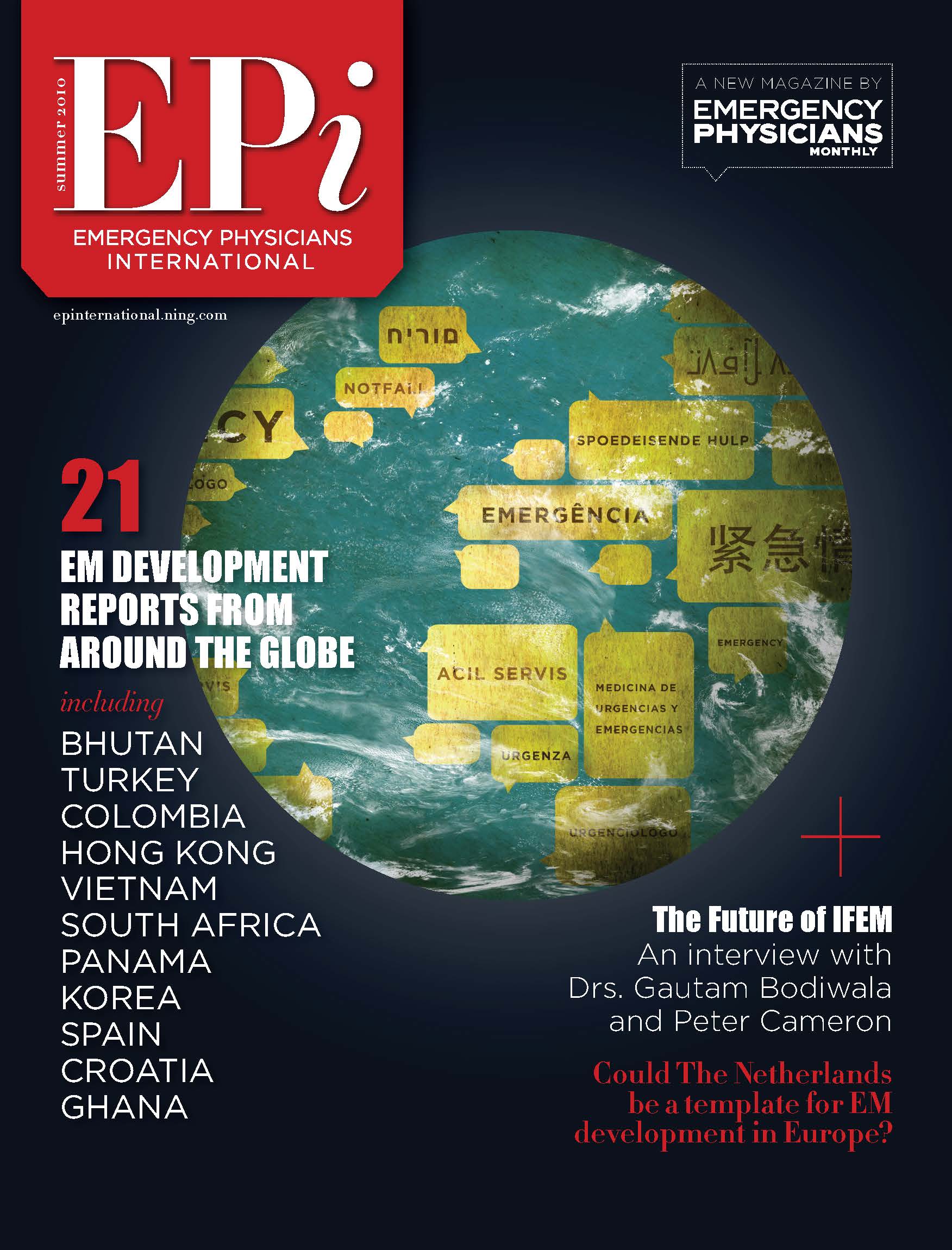Applying Human-Centered Design Principles to Emergency Medicine
A young man is brought to the ED in a war-torn part of world. He is bloodied, bruised, and crying out in pain. Only 60 minutes earlier he was sitting with friends at a café when an explosion and gunfire erupted. Now, he sits on a trolley in an ED corridor. The ED staff are overwhelmed with the casualties. Adding to the challenge is the reality that the hospital is regularly “off the grid.” Access to running water and electricity is unreliable at best, and the gas-powered generator is running out of fuel.
A world away, a large extended family begins to gather around the bed of the family matriarch. Elderly and frail, her disease has taken its toll and she is nearing death. As she lies in her ED bed the staff are making every effort to ensure her comfort. Her family has begun their culture’s death ritual. It’s long and complicated, but beautiful nonetheless.
Elsewhere, a 5-year-old boy is hurried through the ED entrance by his parents. They are rushed and nearing a panic state. It seems their little boy tried to test the boundaries of his bicycle riding abilities. Things were going well until he hit a hole in the road. He’s got a few scrapes and bruises but seems alright otherwise. In fact, his parents seem more stressed about the situation than he does.
Three patients. Three stories. Three very different ED experiences.
Over the last decade I’ve had the opportunity to offer assistance to EDs around the globe—EDs large and small, from Asia to North America, Europe, Africa, and beyond. Early in my career in ED design, I dedicated the majority of my focus and resources to helping organizations create spaces reflecting world-class ED design. I, like the large majority of my colleagues in ED design, focused on volume projections, technologies, and many of the quantitative aspects of creating clinical spaces. Only, something was missing. It turns out that something was human-centered design.
Human-centered design is a framework that develops solutions to problems by actively engaging stakeholder perspectives in all steps of the process. In a less academic vernacular, human-centered design is all about understanding the lives of stakeholders, be they patients, providers, EMS staff, families, or hospital administrators. It’s about understanding their backgrounds, their goals, their values, the challenges they encounter, and the fears they face when it comes to emergency care.
Why does any of this matter? Isn’t an ED just an ED? Don’t healthcare architects know enough about ED design to make the right choices? Don’t physicians and nurses know best how the ED needs to function? Simply put, no. Anyone who tells you they have all the answers is invariably wrong.
Every healthcare organization, every ED, is its own unique ecosystem. This ecosystem evolves in direct response to internal and external influences; in other words, it adapts to survive. Planning an ED to manage patient volumes when the bus pulls up and 40 or 50 laborers step off and walk into the ED for their episodic care is very different from planning an ED in a community where ED waiting room times are posted on billboards along the highway in an effort to entice people to come to the ED. Planning an ED that exists as a part of a hospital lacking an ICU or access to a surgeon is very different than planning an academic ED with all of the latest and greatest technologies at the ready.
With the understanding that healthcare systems are like localized micro climates, how do you plan an ED that balances best-practice design against local realities of healthcare delivery and resource availability, to say nothing of the cultural nuances tied to healthcare and its role in the larger community? How can the ED you design work for patients, families, providers, and work within the healthcare system? It’s not as difficult as you may think, but it does require focus and discipline.
There are countless iterations of human-centered ED design used by design experts. One of the more successful is a five-step process that begins long before architects begin drawing floor plans and continues well into design of the physical spaces.
Understand. The process of designing a new ED begins by understanding the current state of emergency care. Understanding today requires an appreciation of not only quantitative data such as ED volumes, arrival distribution patterns, quality metrics, and cost models but it also includes developing a healthy knowledge of the qualitative factors that can influence emergency care. For example, what are the goals patients and providers have with respect to the ED care process? What are the barriers that currently prevent realizing these goals? What are the implicit, explicit, and latent needs tied to the ED care process? The needs surrounding the ED patient in a war-torn part of the world are very different from those in a wealthy community where the ED is used partially as a convenience more so than a necessity.
It’s also important to understand the evolutionary factors that may affect tomorrow’s emergency care: ED volumes may change over time, new or expected regulatory changes may affect ED care delivery, and new technologies will find their way into emergency care. In consideration of factors such as these, how is the model of care evolving in the community, and how will the ED need to respond?
In almost every instance, developing a true understanding of today’s realities has a profound influence on the design process. It provides an opportunity to use the design process to craft solutions to challenges we might not have even known existed.
Define. The next step in any design project is to define what success looks like. In reference to the three aforementioned patients and the EDs they’ll access, the definitions of success will look very different at each ED. In an ED without reliable access to energy infrastructure, success may be defined as ensuring the power stays on. In an ED in a community with deep and rich cultural customs, success may take the form of ensuring healthcare doesn’t interfere with or disrespect tradition. In an ED that functions as a profit center, success might mean designing systems to attract patients willing to pay cash for their care.
In any case, establishing critical success factors for the ED is an important way to communicate what matters in the future design and what needs to be top-of-mind for the architecture team, who may or may not know a great deal about your community. When defining success, it’s important to move beyond the obvious areas of clinical quality and efficiency and to consider what success might look like if we were to consider the final performance of the ED, patient satisfaction, staff satisfaction, or ability to successfully manage future growth.
Brainstorm. It’s been said that the best way to get a good idea is to get a lot of ideas. The next step in the design process is to begin brainstorming solutions to respond to your understanding of the current state of the project, the challenges that exist, and the established definitions of success.
This stage is an opportunity to dream big, exercise creativity, and take some risks in a safe environment where no idea is a bad idea. Engaging physicians, nurses, technicians, patients, families, and others into the process provides a unique opportunity to approach the same challenge from different perspectives while neutralizing the user bias that clinicians have when designing solutions.
By the end of the brainstorming process, a number of outputs should be completed. Most importantly, patient and process flow diagrams should be finalized and handed off to the architectural design team. These diagrams are invaluable for helping the architectural team understand how the spaces they are creating will be used. This facilitates the objective evaluation of multiple design solutions to understand how each solution supports the proposed processes. Equally important, the process flow diagrams serve as a memorializing document that guides staff training when the time comes to prepare for building occupancy. The diagrams also help to ensure that plans that have been developed survive any staffing changes that occur during the design project.
High-fidelity mock-up of rooms, departments or an entire building facilitate understanding of processes, flows and experiences in three-dimensions. © CannonDesign 2016.
Iterate. A lot of ideas are going to come out of the brainstorming process, and you will need to determine which hold promise and which need to be set aside. During the iteration process, the collaboration between clinicians, patients, architects, and other stakeholders will continue. The goal of this process is to advance potential solutions to the point where they are ready for inclusion into the final design solution.
Going back again to our three patients: each design team may have brainstormed a new approach to the patient arrival and triage process. This is the chance to test the proposed triage solution and try to break it. It’s important to ask why the proposed triage solution might fail and what would have caused the failure. Chances are the causes of failure and the final iteration of the initial solution will look very different at each of the EDs. This is the chance to fix things before they ever break, and is a prelude to the next step in the human-centered design process: prototyping.
Low-fidelity mock-up of patient rooms or other clinical areas can be achieved using simple tools like cardboard or styrofoam. © CannonDesign 2016.
Prototype. ED design and construction projects require a significant investment of time and money. The decisions made during the design process are going to affect how care is delivered in the ED for 10, 20, even 30 years or more. There is one chance to make the right decisions. The wrong decisions can infuse the process with inefficiencies, create patient safety issues, frustrate the staff, and so forth. How do we prevent this, and how do we acquire as much information as possible before finalizing our decisions? We do it by prototyping our proposed solutions.
Prototyping is the process of creating mock-ups of proposed solutions to test the solution and gather more user feedback. Mock-ups range from inexpensive, low-fidelity versions using cardboard, styrofoam, etc., to more sophisticated mock-ups using three-dimensional models or imagery, to fully-functional mock-ups of individual patient rooms, procedure areas or staff work stations with all of the equipment and furniture installed.
The benfits of mock-ups cannot be understated. Giving providers and patients the opportunity to see new environments, which are typically a vast departure from existing spaces, can yield valuable insights. For example, using a treatment station mock-up to explore how the clinical team might deliver care during a major medical resuscitation, management of a STEMI patient, or trauma resuscitation can yield invaluable insights on where to position equipment, supplies, staff documentation stations, handwashing stations, and even the patient trolley.
The human-centered design process, while a proven and successful methodology, is dependent upon a team that is experienced in the process and in how to adapt it to local culture and customs. Spending more time in the pre-design and early design phases can help avoid unnecessary delays and redos during later phases of the design process. Moreover, having the architectural team involved from day one is essential to ensure that outputs of the human-centered design process inform the final architectural solutions. Only through this process can you ensure that the ED caring for patients in the middle of a war zone is not designed to care for patients in the middle of a gated suburban community.









